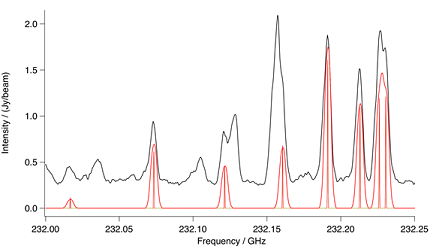Paths Forward
While the model used above is in many ways remarkably successful, it clearly is an oversimplification. There are straightforward extensions. The need for some of these may be revealed by a more numerical fitting and exploration of the residuals, especially in more comprehensive analyses that include ‘all’ molecular species. Others are already well known in the astronomical community.
- Two or more component models: Although the higher angular resolution of ALMA reduces beam averaging, there is still significant averaging, especially along the line of sight. We have not quantitatively included methanol in this analysis because it is well known to have contributions from more than one component [1]. Since the ALMA data of these astrophysical weeds contains many spectral lines that can be compared with the CES it is likely that this information can be used to determine multiple, perhaps many, components – each with its own column density, temperature, and lineshape. Google Scholar
- Isotopic abundances: The impact of non-terrestrial isotopic abundances was illustrated in
. A small extension of the analysis presented above addresses this issue. Briefly, since the ground vibrational states of the less abundant isotopomers are in general much easier to analyze than the excited states of the main isotopomers (even thought they often contribute weaker lines to the astrophysical spectra) many analyses of these isotopomers are included in the QM catalogs. In these cases, simulations that include the abundance of these isotopomers as free variables address this issue.

Figure: 13C Methyl Cyanide Ground Vibrational State. Spectral
comparison in the region of a methyl cyanide ground vibrational state,
13C methyl group bandhead. The upper black trace is ALMA and the
lower red trace a CES LTE simulation at 190 K. Also in red is a stick sp-
ectrum that shows methyl cyanide at laboratory resolution. To account
for the differences in interstellar and terrestrial abundances, the intens-
ity of the simulation has been increased by a factor of 2.5.
If the astrophysical data are sensitive enough to allow observations of excited vibrational states in these less abundant isotopomers and for which there are not QM analyses, the CES from isotopically enriched species can provide laboratory references, with the isotopic abundance as one additional free parameter. - The ALMA data: The comparisons in this paper were made with preliminary results toward the Orion KL hot core region, which is a single pixel in a 1024 x 1024 array of pixels. More complete processing, supplemented with single dish data and utilizing data from other regions in the Orion KL complex, will provide greater opportunity to explore and challenge simulation strategies.